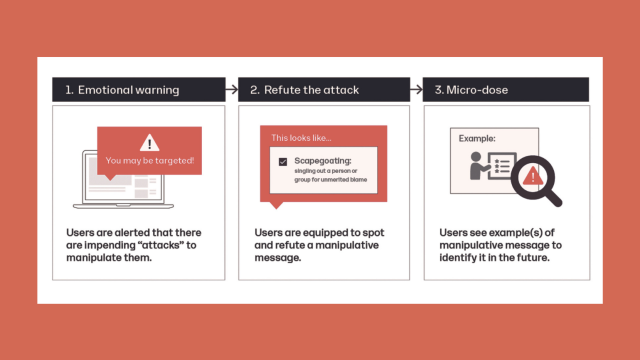It is a common refrain that students need to be taught digital media literacy in school to build resilience against misinformation. While this may be an uncontroversial statement in theory, it is ultimately meaningless when unmoored from specific practices. Indeed, the problem is not that students are not taught digital media literacy but rather that many of them are taught an assortment of outdated and untested methods that can leave them more vulnerable to misinformation and less trusting of high-quality information.
In Canada, for instance, the ability to assess online sources is a curriculum standard in every province and territory. However, in a Canada-wide study of over 2,300 students in grades 9-12, we found that students lacked the fundamental skills required to evaluate information effectively.
In perhaps the most striking example, students were shown a website from a group that presents itself as a medical research organisation but is actually a fringe anti-LGBTQI+ group that has been designated a hate group by the Southern Poverty Law Center (SPLC). They were given access to the internet and asked to rate the site’s reliability as a source of medical information and justify their answer in an open response box. Sixty per cent of students rated the site as reliable, and only 6% determined the website’s agenda.
Accounting for students’ poor performance
To inform their decision, students consistently scoured the page or post looking for superficial signals of authority: they assessed whether the site looked ‘professional,’ they searched for typos, they checked to see if the URL was a .org or a .com (believing, incorrectly, that .orgs all belong to reputable organisations), and they read what the source said about itself on its own ‘About’ page. They tried to apply critical thinking skills to assess the credibility of the website’s claims, but they did not have the necessary subject matter knowledge to make informed judgments. These strategies constantly led them astray.
A mounting body of evidence shows that students’ ability to evaluate online information improves dramatically if they are taught the skills of lateral reading.
Students did not devise these strategies from nothing. As researchers at the Stanford History Education Group (SHEG) have observed, many students were simply applying what they had been taught under the guise of digital literacy. These ineffective strategies are often packaged in checklists for educators to use to teach students how to evaluate information online. Perhaps the most well-known, the CRAAP Test, can trace its lineage to tools developed in the 1990s to help librarians decide which print material to buy. It is widely used to teach digital literacy despite never having been properly evaluated in that context.
Lateral Reading and Context Seeking
The good news is that a mounting body of evidence shows that students’ ability to evaluate online information improves dramatically if they are taught the skills of lateral reading, a term coined by SHEG to describe the process of opening a new tab and conducting quick searches to learn more about a source or claim. Instead of asking students to look closely at online content for clues about its reliability, lateral reading empowers students to use the affordances of the web to gain important context before engaging with the content further.
Lateral reading alone will not solve the problem of misinformation.
In our own study, the same 2,300 students from across Canada who initially fared so poorly demonstrated remarkable gains after completing our lateral reading program. Prior to instruction, students showed evidence of lateral reading just 11% of the time. One week following instruction, students read laterally 59% of the time, and the quality of their assessments improved dramatically as a result. Students who trusted the aforementioned anti-LGBTQI+ site simply because it had a .org domain now conducted searches to learn more about who is behind a site before engaging with it. Students who once dismissed credible news stories simply because they contained typos now cross-referenced claims with professional media sources before deciding whether to believe them.
Lateral reading alone will not solve the problem of misinformation. It cannot account for the myriad cognitive biases people bring to the information they consume and share. It also cannot address the technical and infrastructural issues that enable the global spread of misinformation. But it can begin to address a foundational skills deficit that makes people vulnerable to false and misleading information.
We know lateral reading works, but there is much to be done
We know lateral reading is effective, but these skills are not spreading at the necessary speed or scale. Organisations like our own and SHEG provide evidence-based resources for educators, yet many resource portals for educators still provide lists of outdated tools. Major public awareness campaigns continue to promote ineffective strategies outside of educational settings.
Platitudes about the need for digital media literacy, in general, are not enough. What is required is a whole-of-society approach to communicate evidence-based best practices and to support the continued evaluation of interventions within different local and global contexts. We do not just need ‘more’ digital media literacy; rather, we need to be more intentional about precisely what kind of digital media literacy we need to meet the moment.
Dimitri Pavlounis is the Director of Research and Kelsey Davis is the Digital Literacy Program Manager at CIVIX. CIVIX is a Canadian civic education charity dedicated to building the habits of active and informed citizenship among school-aged youth through experiential learning programs.
Read more
Breakstone, J., Smith, M., Wineburg, S., Rapaport, A., Carle, J., Garland, M., & Saavedra, A. (2021) Students’ Civic Online Reasoning: A national portrait. Educational Researcher. https://purl.stanford.edu/cz440cm8408
Brodsky, J. E., Brooks, P. J., Scimeca, D., Todorova, R., Galati, P., Batson, M., Grosso, R., Matthews, M., Miller, V., & Caulfield, M. (2021) Improving college students’ fact-checking strategies through lateral reading instruction in a general education civics course. Cognitive Research: Principles and Implications, 6(1). https://doi.org/10.1186/s41235-021-00291-4
Caulfield, M. (2018) A short history of CRAAP. HAPGOOD. https://hapgood.us/2018/09/14/a-short-history-of-craap/
Kohnen, A. M., Mertens, G. E., & Boehm, S. M. (2020). Can middle schoolers learn to read the web like experts? Possibilities and limits of a strategy-based intervention. Journal of Media Literacy Education, 12(2), 64-79. https://doi.org/10.23860/JMLE-2020-12-2-6
Pavlounis, D., Johnston, J., Brodsky, J., & Brooks, P. (2021) The Digital Media Literacy Gap: How to build widespread resilience to false and misleading information using evidence-based classroom tools. CIVIX Canada. https://ctrl-f.ca/en/the-evidence/
Wineburg, S., Breakstone, J., Ziv, N., & Smith, M. (2020) Educating for Misunderstanding: How Approaches to Teaching Digital Literacy Make Students Susceptible to Scammers, Rogues, Bad Actors, and Hate Mongers (Working Paper A-21322). Stanford History Education Group. Stanford University. https://purl.stanford.edu/mf412bt5333
Wineburg, S., McGrew, S. (2019) Lateral Reading and the Nature of Expertise: Reading Less and Learning More When Evaluating Digital Information. Teachers College Record, 121(11), 1–40. https://doi.org/10.1177/016146811912101102
Copyright Information
© VectorMine | stock.adobe.com







